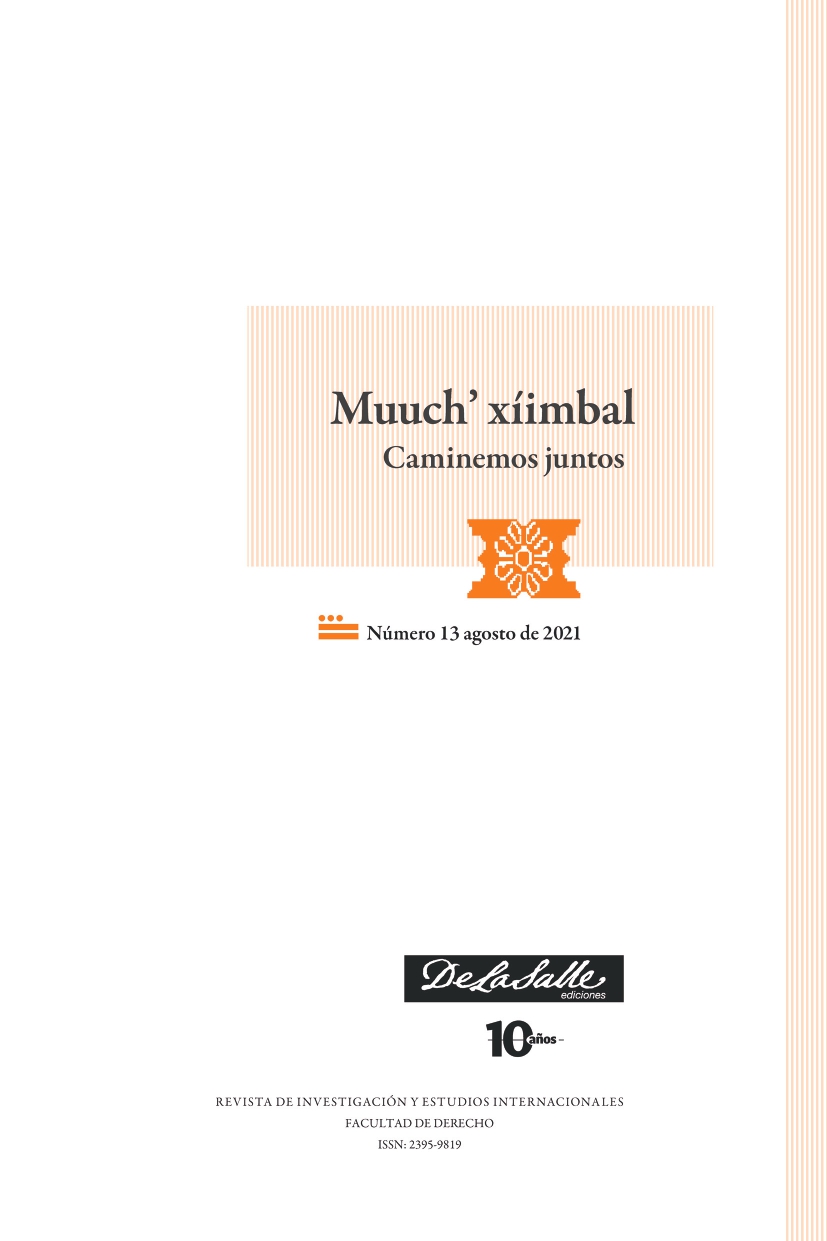Una aproximación a la situación de las mujeres en el Irán contemporáneo: perspectivas locales y globales
DOI:
https://doi.org/10.26457/mxcj.v0i13.2975Resumen
El objetivo de este artículo es destacar algunos de los factores que influyen en la situación actual de las mujeres en Irán. Se sostiene que su posición en la sociedad puede ser entendida a partir de la influencia de factores locales y globales. Los locales son la ley de la familia, las características del sistema político iraní y las condiciones educativas y laborales. Respecto a los factores globales, se hace énfasis en las agendas de los organismos internacionales, las sanciones económicas impuestas por el gobierno estadounidense y los movimientos feministas transnacionales.
Palabras clave: Género, Feminismo, Medio Oriente, Irán, Organismos Internacionales
Referencias
Alikarami, L. (2014, 18 de diciembre) CEDAW and the quest of Iranian women and gender equality. Open Democracy. https://www.opendemocracy.net/en/5050/cedaw-and-quest-of-iranian- women-for-gender-equality/
Anaya, A. (2017). Los regímenes internacionales de derechos humanos: la brecha entre compromiso y cumplimiento. Revista del Instituto de Ciencias Jurídicas de Puebla, 11(40), 159-181. http://www.scielo.org.mx/pdf/rius/v11n40/1870-2147-rius-11-40-00159.pdf
Aryan, K. (2016). The Boom in Women’s Education. En Women, Power and Politics in 21st century Iran. Routledge.
Antón, S. (2015, 21 de octubre) Vigilancia y límites al programa nuclear de Irán: el Plan de Acción Integral Conjunto (JointComprehensive Plan of Action, JCPOA). Real Instituto Elcano. https://tinyurl.com/3jpndwra
Bahramitash, R. (2007). Iranian women during the reform era (1994-2004). A focus on employment. Journal of Middle East Women’s Studies, 3(2). 86-109.
Bahramitash, R. & Esfahani, H. (2011). Modernization, Revolution, and Islamism. Political Economy of Women’s Employment. En Veiled Employment. Islamism and the political economy of women’s employment in Iran. Syracuse University Press.
Bakhshizadeh, M. (2018) Changing Gender Norms in Islam Between Reason and Revelation. Budrich UniPress.
Banco Mundial. (2021). Islamic Republic of Iran. Overview. https://www.worldbank.org/en/country/iran/overview#1
Banco Mundial. (2021a). Tasa de participación en la fuerza laboral. https://datos.bancomundial.org/indicator/SL.TLF.ACTI.FE.ZS?locations=IR
Banco Mundial. (2021b). Unemployed male. https://data.worldbank.org/indicator/SL.UEM.TOTL.MA.ZS?locations=IR
Center for Human Rights in Iran. (2015, 19 de octubre). Narges Mohammadi Should Be Released Immediately and Given Medical Treatment. https://www.iranhumanrights.org/2015/10/narges-mohammadi-8/
Change for Equality. (2006, 27 de agosto). Petition: International Support for Women’s Campaign. https://www.we-change.org/english/spip.php?article19
Departamento del Tesoro de Estados Unidos (2018). Re-imposition of the sanctions on Iran that had been lifted or waived under the JCPOA. https://tinyurl.com/fw97a9s
Espinosa, A. (2020, 26 de febrero). Los conservadores se consolidan en Irán en unas elecciones con una elevada abstención. El País. https://elpais.com/internacional/2020/02/26/actualidad/1582737801_978726.html
Foro Económico Mundial. (2020). Informe Mundial de Brecha de Género. https://www.weforum.org/reports/gender-gap-2020-report-100-years-pay-equality
Ghorashi, H. & Tavakoli, N. (2006). Paradoxes of transnational space and local activism: Iranians organizing across borders. Focaal—European Journal of Anthropology, 47, 90–102. https://tinyurl.com/39af45kd
Golkar, S. (2015). Captive Society. The Basij Militia and Social Control in Iran. Columbia University Press.
Human Rights Watch. (2020). Iran. Events of 2019. https://www.hrw.org/world-report/2020/country-chapters/iran#
Iranian Women’s Studies Foundation. (2021). Statement of Purpose. https://www.iwsf.org/about-us
Jaafari S. (2020, 3 de septiembre). Iranians shares stories of sexual harassment, abuse on social media. The World. https://www.pri.org/stories/2020-09-03/iranians-share-stories-sexual-harassment-abuse-social-media
Kalhor, N. (2019, 15 de agosto). Improved employment leaves Iran’s women, youth behind. Al-Monitor. https://www.al-monitor.com/originals/2019/08/iran-improved-employment-women-youth-left-behind.html
Kar, M. & Farshi, F. (2008). Focusing on Women in the Internal Politics of Iran. The Brown Journal of World Affairs, 15(1). https://www.jstor.org/stable/24590950?seq=1#metadata_info_tab_contents
Kardam, N. (2002). The Emergence of a Global Gender Equity Regime. International Journal, 57 (3), 411- 438.
Kian, A. (2005). From motherhood to equal rights advocates: The weakening of patriarchal order. Iranian Studies, 38(1). https://www.jstor.org/stable/4311705?seq=1
Kian, A. (2012). Gendered citizenship and the women’s movement in Iran. En Iran: a revolutionary republic in transition. European Union Institute for Security Studies.
Kian, A. (2013). Social and cultural change and the women’s rights movement in Iran. En Cultural revolution in Iran. Contemporary Popular Culture in the Islamic Republic. Tauris.
Koo, G. Y. (2016). To be Myself and have My Stealthy Freedom: The Iranian Women’s Engagement with Social Media. Revista de Estudios Internacionales Mediterráneos, 21. http://dx.doi.org/10.15366/reim2016.21.011
Mir-Hosseini, Z. (1993). Women, Marriage and the Law in Post-Revolutionary Iran. En Women in the Middle East. Perceptions, Realities and Struggles for Liberation. Palgrave Macmillan.
Moaveni, A. & Tahmasebi, S. (2021, 27 de marzo). The Middle-Class Women of Iran Are Disappearing. The New York Times. https://www.nytimes.com/2021/03/27/opinion/sunday/iran-sanctions-women.html
Moaveni, A. & Vaez, A. (2020, 6 de marzo) U.S. ‘Maximum Pressure’ on Iran Hurts the Women It Claims to Help. Crisis Group. https://tinyurl.com/292nf7zz
Navas, M. (2018). Equidad de género: una aproximación histórica a las políticas públicas para la equidad de género en El Salvador (2017). En Antología del pensamiento crítico salvadoreño contemporáneo (pp. 347-366). CLACSO. doi:10.2307/j.ctvfjd0vt.15
Nayereh, T. (2016). Women’s rights and feminist movements in Iran. Sur 24, 13(24), 75-89. https://papers.ssrn.com/sol3/papers.cfm?abstract_id=3028205
Nejadbahram, Z. (2016). Women and Employment. En Women, Power and Politics in 21st century Iran. Routledge.
ONU Mujeres. (2011). Convención sobre la Eliminación de Todas las Formas de Discriminación contra la Mujer. https://tinyurl.com/2h6yc395
ONU Mujeres. (2021). Comisión de la Condición Jurídica y Social de la Mujer.
https://www.unwomen.org/es/csw
Osanloo, A. (2009). The Politics of Women’s Rights in Iran. Princeton University Press.
Povey, T. (2016). The Iranians Women’s Movement in its Regional and International Context. En Povey, T. & Rostami-Povey, E. (Ed.) Women, Power & Politics in 21st Century in Iran. Routledge.
Rogin, J. (2018, 21 de mayo) Opinion: Pompeo’s Iran strategy speech lacked a real strategy. The Washington Post. https://www.washingtonpost.com/news/josh-rogin/wp/2018/05/21/pompeos-iran-strategy-speech-lacked-a-real-strategy/
Sadeghi, F. (2009). Foot Soldiers of the Islamic Republic’s ‘Culture of Modesty’. Middle East Report, The Islamic Revolution, 250. http://www.jstor.com/stable/27735286.
Sephri, T. (2017). “It’s a Men’s Club” Discrimination Against Women in Iran’s Job Market. Human Rights Watch. https://www.hrw.org/report/2017/05/25/its-mens-club/discrimination-against-women-irans-job-market
Sreberny, A. (2013). Thirty-plus years of the Iranian Revolution:Culture in contestation. En Cultural revolution in Iran.Contemporary Popular Culture in the Islamic Republic. Tauris.
Tahmasebi, S. (2018, 10 de agosto). How US Sanctions Impede the Women’s Movement in Iran. Atlantic Council. https://www.atlanticcouncil.org/blogs/iransource/how-us-sanctions-impede-the-women-s-movement-in-iran/
Tajali, M. (2015). Islamic Women’s Groups and the quest for Political Representation in Turkey and Iran. Middle East Journal, 69(4). doi.org/10.3751/69.4.14
Universidad Estatal de California, Northridge. (2021). Nayereh Tohidi. https://www.csun.edu/humanities/gender-womens-studies/nayereh-tohidi
Vakil, Sanam. (2011). Women and politics in the Islamic Republic of Iran. Action and reaction. The Continuum International Publishing Group.
Yassari, N. (2002). Iranian Family Law in Theory and Practice. Yearbook of Islamic and Middle Eastern Law Online, 9(1). https://doi.org/10.1163/22112987-91000006
Women’s Committee of the National Council of Resistance of Iran. (2016). Why the Iranian Regime Does Not Join the CEDAW? https://women.ncr-iran.org/2016/03/05/why-the-iranian-regimedoes-not-join-the-cedaw/
World Economic Forum. (2020). Global Gender Gap Report 2020. World Economic Forum. https://www.weforum.org/reports/gender-gap-2020-report-100-years-pay-equality
Zaccara, L. (2006). Los enigmas de Irán. Sociedad y política en la República Islámica. Capital Intelectual.




